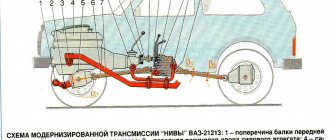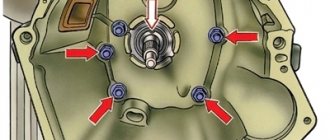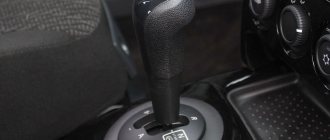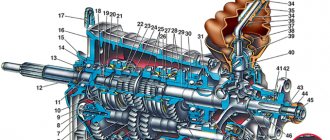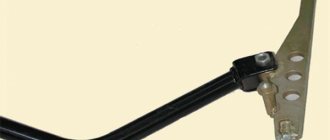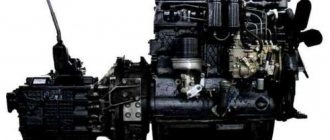Everyone knows that in a car, a mechanical differential with manual or automatic gear shifting is used to connect the power unit with the chassis and change the traction force on the wheels.
A gearbox is a complex transmission mechanism for mobile vehicles, designed to expand the range of rotation speed and torque transmitted from the engine, the possibility of short-term or long-term disconnection of the internal combustion engine from the chassis, and regulation of the direction of movement of the vehicle.
Diagram of a 5-speed gear shift mechanism for VAZ-2123
At the factory, modern Niva cars are equipped with a five-speed gearbox , made according to the three-shaft design.
Gearbox design:
The main elements of the box body are the clutch dome, the gearbox housing itself and the rear cover. The production of frame parts is carried out at the plant from a modern aluminum alloy with chemical additives.
Heat removal from heated rubbing parts is realized by manufacturing a multi-fin structure on the surface of the crankcase and also to protect the speed selection unit from overheating and exceeding excess pressure, a breather is present in the design.
The tightness of body connections is ensured through the use of pressed shaped gaskets. In case of repair of the gear selector assembly, it is also possible to use a liquid gasket former. The lower part of the gearbox housing is covered with a stamped steel protection with a gasket.
In a modern design, the gearbox housing and synchronizer clutches are reliable and adapted to operating conditions on Russian roads.
The factory crankcase protection on the Chevrolet Niva copes with its function quite well. For safe travel on rural roads and off-road, you can consider installing additional combined protection for the gearbox and transfer case. There are many different options and designs offered on the Internet, where you can choose the option you like, both in price and in terms of configuration and quality of metal.
Design and principle of operation of the VAZ Niva gearbox
Gearbox of a Niva VAZ 2121 car, device
Device. Depending on the vehicle's configuration, it may be equipped with a four- or five-speed gearbox. The latter is designed on the basis of a four-speed gearbox, therefore the subsection describes the design and repair of a four-speed gearbox, and at the end of it - the features of the design and repair of a five-speed gearbox.
In both types of gearboxes, gears of the same name have single-digit gear ratios. Until 1987, the previously installed gearbox had different gear ratios: I - 3.242; II - 1.989; III - 2.89; IV - 1.00; Z.H. - 3,340.
The primary shaft 46 (Fig. 75) of the gearbox has two ring gears. The ring 1 with oblique teeth is in constant engagement with the gear 42 of the intermediate shaft, and the ring 3 with straight teeth is the crown of the 4th gear synchronizer; the intermediate shaft 40 is a block of four gears. The secondary shaft 10 is mounted on three bearings, with bearing 2 located in the socket of the primary shaft. Gears 7 and 8 rotate on heat-treated journals of the secondary shaft, and gear 11 on a steel bushing 12.
Design and principle of operation of the VAZ Niva gearbox
The Niva 21213 gearbox is mechanical, with manual shifting, has five forward gears and one reverse gear, all forward gears are synchronized. It is unified with gearbox 2107; Only the rear cover is slightly different: the hole for the speedometer drive is closed with a plug, since the Niva’s speedometer is driven from the transfer case. Currently, all gearboxes use the 2105 gearbox ratio.
The body parts of the box - the clutch housing, the gearbox housing itself and the rear cover - are cast from aluminum alloy and tightened together with studs and nuts. The connections are sealed with cardboard gaskets (sealant can be used during repairs). To improve heat dissipation, the surface of the gearbox housing is finned. The bottom of the crankcase is closed with a stamped steel cover with a gasket (fastening with studs). The clutch housing is bolted to the engine cylinder block. To ensure alignment of the crankshaft and the input shaft of the gearbox, the crankcase is centered on two bushings (grooves are made for them in the mounting holes of the block and crankcase). The third support of the power unit is installed on the rear cover of the gearbox. It is attached to the cross member, and the latter is attached to the body floor (with welded bolts).
In the VAZ Niva gearbox housing there is a filler (control) hole on the left side, and a drain hole in its bottom cover. The holes are closed with plugs with conical threads. There is a magnet in the drain plug. It traps steel particles that enter the oil when parts wear. A breather is screwed into the upper part of the clutch housing. It prevents the pressure in the gearbox from increasing when it heats up. If the breather malfunctions (the cap is jammed), severe oil leakage through the seals is possible.
The gearbox has three shafts: the Niva primary shaft, the secondary and the intermediate. The input shaft rests on two ball bearings - at the rear end of the crankshaft and at the front wall of the gearbox housing (the latter takes up the bulk of the load). A needle bearing is installed at the rear end of the primary shaft, which is the front support of the secondary shaft and ensures the alignment of the shafts. The output shaft is also supported by a ball bearing in the rear wall of the transmission housing and a roller bearing in the rear cover. The intermediate shaft rotates in two bearings: the front one is a double-row ball bearing, located in the front wall of the gearbox housing, the rear one is a roller bearing, located in its rear wall. Through the reverse and fifth gear assembly, the intermediate shaft also rests on a roller bearing in the rear cover of the transmission. The axis of the reverse intermediate gear is also attached to the rear wall of the box housing.
The input shaft of the Niva gearbox has two ring gears. The helical ring, located closer to the front wall of the crankcase, is in constant mesh with the countershaft front gear (thus, these shafts always rotate together). The spur gear of the input shaft is the crown of the fourth gear synchronizer (when it is engaged, torque is transmitted directly from the input shaft to the secondary shaft, bypassing the intermediate one, which is why this transmission is often called “direct”).
The intermediate shaft is a block of four helical gears. When engaging any gear except fourth, torque is transmitted to the secondary shaft through the intermediate one. The intermediate shaft gears are located in the following order (from its front end): gear of constant engagement with the input shaft, gears of the third, second, first gears. A block of two gears is bolted to the rear end of the shaft: reverse (straight) and fifth gear (helical). It is additionally supported by a roller bearing in the rear gearbox cover.
On the secondary shaft there are driven gears of the third, second, first gears, reverse and fifth gears (in order, counting from the front end of the shaft) and synchronizers. The driven gears of the forward gears are in constant mesh with the corresponding gears of the intermediate shaft. The gears of the third and second gears of the VAZ Niva gearbox rotate on hardened journals of the secondary shaft, the gears of the first and fifth gears - on bushings. The reverse driven gear is rigidly secured to the shaft with a key. Together with the helical gears of the forward gears, the rims of their synchronizers are made - spur gears of smaller diameter. They are directed towards the corresponding synchronizer (third, first, fifth - forward, second - backward). A flange of an elastic coupling is secured with a nut at the rear end of the secondary shaft. Previously, the nut was prevented from being loosened by a lock washer placed under it - its edges were bent back at the edge of the nut. Now anaerobic sealant is applied to the threads, but the washer is not installed.
The synchronizer consists of a hub rigidly mounted on the secondary shaft, a sliding clutch, a retaining ring, a locking ring and a spring with a washer. The third-fourth and first-second gear synchronizer hubs fit into grooves on the secondary shaft with internal projections, and the fifth gear synchronizer hub is held by the same key as the reverse driven gear. On the outer surface of the hubs there are splines along which sliding couplings move. The couplings have recesses into which the shift rod forks fit. The locking rings with their inner rims are connected to the synchronizer rims of the corresponding gears and are pressed by springs towards the sliding clutches. The springs rest on the side surface of the driven gears through washers.
The reverse gear does not have a synchronizer. To engage it, you need to engage the intermediate gear with the driven gear of the secondary shaft and with the reverse drive gear in the rear gear block on the intermediate shaft.
The gearbox control drive consists of three rods connected to forks. The forward gear shift forks fit into the grooves of the synchronizer sliding clutches, and the reverse gear shift fork fits into the groove on the intermediate gear.
The gear selection mechanism consists of a guide plate with eight rectangular cutouts in the center, upper and lower washers, a gear shift lever and its housing, and a reverse locking bracket. These parts are secured with three bolts that secure the gear selection mechanism to the rear cover of the box. The "neutral" position of the lever between third and fourth gears is set by two pairs of spring-loaded guide bars installed in the grooves of the guide plate and acting on the lower end of the lever. Accidentally engaging reverse instead of fifth gear is impossible thanks to the bent petal of the locking bracket, into which the protrusion on the lever rests. To engage reverse gear, you need to press the lever down - in this case, its protrusion drops below the tab of the bracket.
Transmission parts are splash lubricated. The primary and secondary shafts are sealed with oil seals, and an oil slinger is located on the secondary shaft behind the fifth gear driven gear. The VAZ Niva 21213, 21214 gearbox is filled with transmission oil with a viscosity of 75W80 to 85W90 and a quality class of at least GL-4. Its level should be at the lower edge of the filler hole (first make sure that the car is level).
Rice. 75. Four-speed gearbox: 1 - constant engagement ring of the input shaft; 2 — lobed bearing; 3 — gear ring of the 4th gear synchronizer; 4 — sliding clutch for synchronizer of 4th and 3rd gears; 5 — synchronizer blocking ring; 6 — synchronizer spring; 7 — gear III gear; 4 - 2nd gear gear; 9 — hub of the sliding clutch for the synchronizer of 1st and 2nd gears; 10 - secondary shaft; 11 — 1st gear gear; 12 — gear bushing; 13 — intermediate bearing of the secondary shaft; 14 — reverse gear; 15 — outer cover; 16 — lever rod; 17 - thrust pad; 18 - elastic bushing; 19 — spacer sleeve; 20 — locking sleeve; 21 — inner cover; 22 — spherical washer of the ball joint; 23 — gear shift lever; 24 — back cover; 25 — oil seal; 26 - nut; 27 - seal spring; 28 — centering ring of the elastic coupling; 29 — centering ring seal; 30 — elastic coupling flange; 31 — rear bearing of the secondary shaft; 32 — spacer sleeve; 33 — reverse fork; 34 — reverse intermediate gear; 35 — reverse gear of the intermediate shaft; 36 — axis of the reverse intermediate gear; 37 — sliding clutch for synchronizer of 1st and 2nd gears; 38 — bottom cover; 39 — filler and control plug; 40 — intermediate shaft; 41 — gearbox housing; 42 — constant mesh gear of the intermediate shaft; 43 — front bearing of the intermediate shaft; 44 - bolt; 45 — washer; 46 - input shaft; 47 — front cover; 48 — rear bearing of the input shaft; 49 — clutch housing; 50 — breather
Rear and front gear ratios of Chevy Niva
Gear values for Chevrolet Niva manual transmission from 2002 to present:
- I – 3.67;
- II – 2.10;
- III – 1.36;
- IV – 1.00;
- V – 0.82;
- 3rd gear transmission – 3.53.
To engage the gearbox, you need to move the gearshift lever all the way to the right and push it down with a little force, pressing the gearshift knob in the direction of the rear seats of the car.
The VAZ-2123 gearbox does not have a separate synchronizer for the reverse gear. Accidental engagement of reverse gear is eliminated due to the use of a curved locking stop in the form of a bracket in the design.
Important! The reverse speed of the Niva Chevrolet gearbox, like any car, must be turned on when the car is completely stopped.
What do you need to know about the Niva 21213 gearbox?
The Niva car is positioned as an SUV that has increased cross-country ability. Due to this, there is a demand for the car. A durable load-bearing body has been installed. The Niva 2131 model is built on the basis of the LADA 4×4. Its tuning allows you to change the exterior and performance characteristics for the better. Since the mid-1990s. Injection engines have become available for Niva cars.
In addition to passenger cars, self-propelled vehicles are also produced under the Niva brand. In particular, this is Niva SK 5. This vehicle is a combine harvester designed for harvesting crops. The machine runs on diesel fuel.
Differential
This mechanism is a kind of distributor of traction forces coming from the motor to the wheels. An important feature is that the latter have the ability to rotate at different speeds. The importance of having a differential mechanism is due to the fact that during turning maneuvers, the wheel located inside makes fewer revolutions when compared with the number of turns of the outer wheel.
In the absence of a differential mechanism, this would cause detrimental consequences, such as wear and damage, because the result would be the following: when turning, one wheel would be in a slip state, and the second would simply rub against the road surface. The design features of the Niva transmission provide for the presence of 3 differentials. They are located in each of the bridges and in the transfer mechanism.
When the car moves on a flat road and in a straight line with differentials, the traction force is divided equally between all 4 wheels. If there is insufficient adhesion of the wheels to the surface or slipping occurs, the differentials will redistribute the load on the slipping and sliding wheel so that the first receives more force, and the second, accordingly, less.
We have already mentioned UAZ. Despite many similarities, it should be understood that the VAZ’s all-wheel drive is made in the “pat-time” style. This means that when connected, the axes are firmly connected to each other, and rotation occurs at the same speeds. This device imposes some restrictions on the use of all-wheel drive - it can only be used in cases where road conditions allow slipping. In cases with hard asphalt roads and highways, it is recommended to switch the car to single-drive mode.
Other parts and mechanisms
Among other elements of the unit in question, the following devices can be noted:
- Transfer of movement back. It does not have a synchronizer; activation is carried out by introducing an intermediate gear with a driving analogue of the secondary shaft and the same part on the intermediate roller.
- The Niva-2121 gearbox has a control drive consisting of three rods that are aggregated with forks. The last elements are placed in the sockets of the sliding clutches, and the reverse gear analogue is placed in the groove of the intermediate gear.
- The lubrication mechanism involves processing the parts of the assembly by splashing. The shafts are sealed with oil seals; the secondary shaft of the fifth gear has an oil deflector in the form of a washer. The filled oil level should reach the bottom edge of the fill socket.
In what cases is this procedure necessary?
With proper operation, the gearbox can last quite a long time, since it is a self-sufficient design element that does not require frequent maintenance. On the Chevrolet Niva, the gearbox is designed in such a way as to satisfy the off-road ambitions of the crossover, because initially this car was equipped with all-wheel drive in order to overcome various obstacles. This means that the car’s transmission is designed for increased loads. But it is necessary to take into account such processes as metal fatigue and the production of parts. Over time, under increased loads, the gearbox begins to operate for a long time, experiencing overheating, which leads to expansion of parts and increased wear.
There may be several main reasons when it is necessary to remove the gearbox:
- Dismantling to completely replace the entire mechanism. It is usually rarely used in practice, since in most cases it is possible to repair an old gearbox except in cases where the housing is damaged.
- To carry out maintenance. Components can be cleaned or consumables can be replaced: oil seals, slides or gaskets, depending on the specific case.
- When carrying out other repair work, when the gearbox will prevent access to the desired unit.
Before removing the gearbox, you must carefully study the feasibility of these actions. For processes such as changing the oil, installing a rocker seal or clutch cylinder, removing the box is not required.
Problems with the box
The Niva Chevrolet car, and in particular its gearbox element, as they say, is good, but with its own “peculiarities”. Somewhere after the first 50 thousand km, the device begins to show its teeth. There may be a hum or unusual noise. Such “features” make it clear that the bearings or gears are worn out. If you watch the gearbox for some time, you can determine what exactly needs to be replaced. What other problems can occur with the gearbox?
- Noise, grinding or knocking when the car is moving, and sometimes when warming up.
- Shocks when changing gears.
- The gearbox may refuse to disengage a particular gear.
- Deformation of the lever, which promises complications during the gear shift process.
- Also, transmissions can simply be knocked out.
For each item listed above, there are reasons and ways to solve them. But today we will look at a specific problem - the knocking of the Niva Chevrolet gearbox and we will carry out the repair ourselves.
A knocking sound when the car is moving or when warming up indicates that the bearings, gears, shaft (primary) or axial ones in the gearbox have worn out. Actually, determining what exactly was the reason is sometimes very difficult. And if you do not have the opportunity to completely replace the gearbox, then your only option is to remove the device manually, disassemble it and carry out minor repairs.
Correct shifting of transmission levers on a Chevrolet Niva
To use the lock installed on the Niva effectively, use the following recommendations from experts: When driving on a good quality road surface, install the front transfer case handle in front and the rear handle in the back. The front handle is moved back if the road becomes slippery. Once the slippery area has been passed, switch the levers to normal mode.
If the Niva is stopped, the lock may not engage when the clutch is depressed.
This occurs due to the alignment of the teeth with the gear teeth. How to turn on the transfer case on a Chevrolet Niva in this case? Moving as if on a turn, engage the lock. The differential will turn and the gear teeth will come closer to the teeth. If turning off is difficult, do it while the vehicle is moving, maintaining a minimum speed and squeezing the clutch.
How the cross-axle differential lock works on a Niva is clearly shown in the video: Among domestic car enthusiasts, the Chevrolet Niva is a fairly popular SUV that appeals not only to fans of extreme driving and adherents of measured driving outside the city. Many people know that one of the features of the transfer case switching on in a Chevrolet Niva of this brand is the presence of a transfer case in it.
Using this unit, you can enable downshifting, locking, or two functions at the same time, depending on the conditions.
The question of how the Niva Chevrolet transfer case should be used correctly is of interest to many happy owners of such a vehicle and those who only intend to purchase it. It should be immediately noted that you can engage both the lock and the transmission at the same time using the Chevrolet lever that changes gears. So, the lever switches to the right, and then immediately switches on the transfer case on a Chevrolet Niva to engage a lower gear.
To switch back to higher, the lever should simply be moved.
Using a Niva Chevrolet transfer case, in addition to switching on the transfer case on a Chevrolet Niva, the neutral gear is also switched on, and the car will remain securely in one place. The lock can be engaged at any time - in a normal gear, in a low gear - just switch the Chevrolet lever to the left. When is a low gear used? For what purposes is a transfer case even needed, when does it make sense to engage locking and low gear? Such seemingly simple, but at the same time serious questions will become clear when considering the following example.
Transmission malfunctions
The gearbox, in its basic design, is a gearbox with a variable gear ratio. Since this is a complex device, there may be several reasons for malfunctions. A gearbox failure can be diagnosed by the following signs:
All possible malfunctions in the trivial classification are divided into malfunctions of the box itself and malfunction of the gear selection mechanism. The first type includes:
Malfunctions of the gear selection mechanism are accompanied by wear of the shift fork, deformation of the rod or rupture of the drive cable. Gearbox repair work requires its preliminary dismantling.
Description of possible problems with the transfer case
During the operation of off-road vehicles, parts and components of the transfer case gradually become unusable due to wear. Most often, the following interruptions in the operation of the mechanism occur:
The transfer case is overheating.
Changing the oil in the transfer case Niva 2121
To ensure the performance of the vehicle, it is necessary to carry out timely maintenance. Changing the oil is included in the mandatory list of machine maintenance work. To change consumables in the Niva 2121 transfer case, you will need 0.8 - 1.5 liters of gear oil.
The frequency of replacing lubricating fluid is equal to 45,000 km of distance traveled. The first procedure is carried out after 60,000 km, and then in accordance with the established schedule.
Attention: If problems arise with shifting gears, extraneous sounds, vibrations and vibrations, it is necessary to check the condition and amount of oil in the transfer case and the transmission as a whole.
The procedure for changing the oil in the transfer case of a Niva SUV:
- warm up car systems and mechanisms, to do this you need to start the engine and drive a short distance;
- install the machine on an overpass or over a special inspection hole;
- clean the filler and drain plugs of the transfer case from dirt and dust;
- place a container under the drain to collect waste material;
- unscrew the plugs and drain the liquid;
- remove metal fragments, shavings, splinters and other wear elements;
- screw in the plug;
- pour into the washing liquid (about one liter);
- start the engine;
- move the lever through the transfer case gears with slight delays;
- turn off the engine;
- drain the flushing composition;
- fill the transfer case with new oil;
- check the oil level;
- if necessary, add the required amount.
For the transfer case of the Niva 2121 SUV, transmission oils of the famous brands Mobil, TNK, Castrol of the GL-4 class are most often used.
vote
Article rating
DIY repair
Gearbox knocking is a fairly common disease and not particularly pleasant. Every time you switch to listen to a rattling sound, you won’t get any nerves. But it is still possible to cure the transmission by carrying out appropriate repairs.
In order to remove the knock of the box, you first need to remove it. To repair the box, you need to have keys (10, 13, 19), a 12 hex key, a screwdriver and pliers. So let's get started:
- Place your machine on a hill or in a hole.
- Disconnect the battery terminal and pour out the oil.
- Get inside the car. Remove the handles from the levers, as well as the transfer cases, the element casing and the cover.
- Remove the casing, boot, lock sensor connector. Remove the gearbox lever itself.
- Set up a gear that reverses, remove the locking sleeve.
- Try to mark the cardan flanges and also the transfer case, so that later you can assemble everything in the correct order.
- Remove the cardan (which is the front one) and the washer (which is the oil deflector).
- Did you see the flange (look at the secondary shaft)? Unscrew the nuts of the elastic coupling from it (this is done with a size 19 wrench).
- Unscrew the nuts on the cushions to the very end of the studs and remove the transfer case.
- Now you need to unscrew the bolts from the cylinder and the starter itself, after first removing the cotter pin and the spring next to it. An extension cord is required for this action.
- And move the starter closer to the radiator.
- Disconnect the sensor that controls the lights (reverse), unscrew the muffler clamp, as well as the bolts from the crankcase and the yoke nuts.
- Unscrew the bolts that hold the box closer to the engine. Carefully disconnect it, just try not to let it hang with all its weight on the input shaft.
- Rock it a little from side to side and gradually move it back until you reach the stop.
- Lower the crankcase down and remove the link from the hole.
Installing the car in the inspection hole
Congratulations, you've removed the gearbox! In order to continue the repair, it needs to be disassembled. You should take your time to disassemble it; immediately prepare a work space for yourself. Advice, lay out all the removed parts exactly in the order in which you remove them, this will greatly simplify the reverse process. As you disassemble the device, observe how the bearings, gears, axles behave, whether there are any abrasions, how the input shaft behaves . You may not have to completely disassemble the element, for example, identifying wear on the bearings is very simple, when you remove the bottom cover, move them a little, if any of the bearings move, it means it is worn out and needs to be replaced. So, let's continue the renovation. You need to do the following:
A necessary tool.
During the process of dismantling the box you will need
- set of wrenches for bolts 10, 12, 13 and 17.
- Set of hexagons from 12 and above
- Container for collecting used oil
- Pliers, Phillips and slotted screwdrivers
- A special stand, suspension or assistant to support the gearbox.
After you have collected all the necessary tools, you can proceed to the actual work.
Carter
The Niva gearbox housing on the left side is equipped with a filler neck, and there is an analogue at the bottom. The holes are blocked with plugs with cone-type threads. The drain compartment has a magnet that traps metal particles that enter the oil due to wear of parts.
A breather is screwed into the top of the crankcase, which prevents the pressure in the gearbox from increasing due to excessive heating. If this element is faulty, lubricant may actively leak through the seals. In this case, the parts dry out, which increases the wear of the components.
1. tension spring; 2. lock nut; 3. adjusting element; 4. cotter pin; 5. fork; 6. pusher; 7. mounting bolt; 8. working cylinder.

